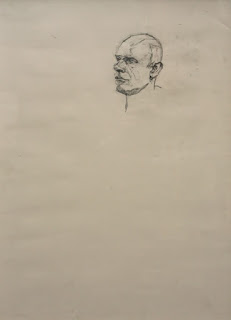Auguste Rodin
Beginning drawing students are often baffled and disheartened by an exercise that has become a canon in art training. I'm talking about the so-called "blind contour" drawing. Pencil to the page and eyes on the model, a line is pulled without watching the pencil. The exercise is unparalleled as a way to begin to develop eye-hand coordination. The more typical sewing machine stitching and symbolizing that typifies beginners' sketching begins to yield to confident, seismographically sensitive lines full of particular information about the subject's actual form. The sculptor Rodin certainly practiced blind drawing routinely as his many studies from the moving model attest. But earlier than Rodin by almost four hundred years another great artist practiced the blind drawing, perhaps not so much from choice but by necessity.
In 1976, numerous large charcoal drawings by Michelangelo were found on the plaster walls of a crypt beneath the New Sacristy in the Medici Chapel in Florence's church of San Lorenzo. Michelangelo, who had grown up in the Medici household virtually as an adopted son, fell out with the Medici after they were ousted from the city in 1520. Flipping his allegiance, Michelangelo designed battlements to protect the city from their return for which he paid by having a bounty placed on his head when they returned to power. Michelangelo hid out in the crypt for about six weeks during which time he occupied his time by drawing in the darkness. In his own words, Michelangelo writes of the conditions:
"I hid in a tiny cell," he wrote, "entombed like the dead Medici above, though hiding from a live one. To forget my fears, I fill the walls with drawings."
Not seeing what he was doing was clearly no impediment to the great master. The lines are as fluid and informed as his life studies. Check out the drawings on the links below.
















